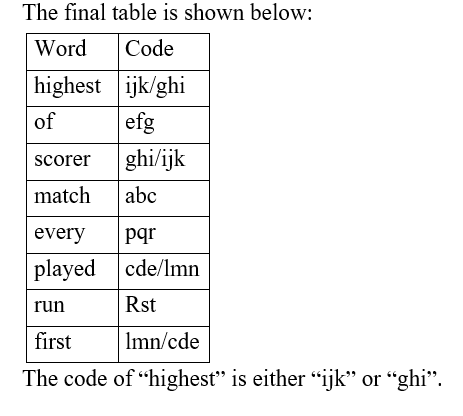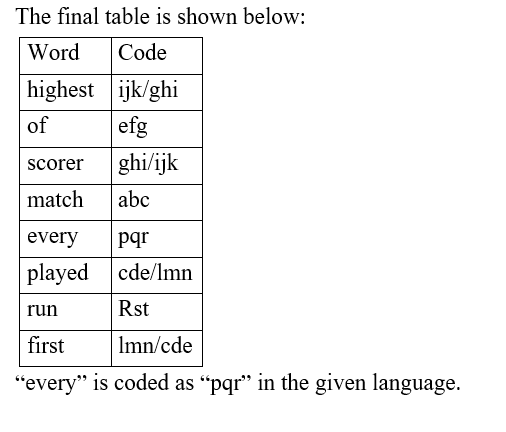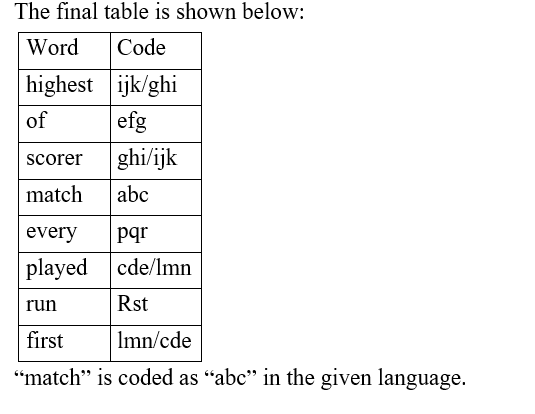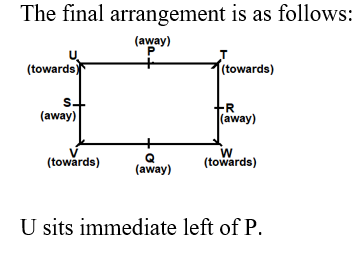Question 1:
निर्देश : निम्नलिखित व्यवस्था का ध्यानपूर्वक अध्ययन करें और प्रश्नों के उत्तर दें।
Directions : Study the following arrangement carefully and answer the questions.
6 H 9 K 3 D V B 2 M 1 Y I 7 O 4 W 5 8 S L P Z R
दी गई व्यवस्था में D और 8 के बीच कितने व्यंजन हैं?
How many consonants are between D and 8 in the given arrangement?
Question 2:
निर्देश : निम्नलिखित व्यवस्था का ध्यानपूर्वक अध्ययन करें और प्रश्नों के उत्तर दें।
Directions : Study the following arrangement carefully and answer the questions.
6 H 9 K 3 D V B 2 M 1 Y I 7 O 4 W 5 8 S L P Z R
व्यवस्था में सभी सम संख्याओं का योग क्या है?
What is the sum of all even numbers in the arrangement?
Question 3:
यदि संख्या 93759268 के अंकों को बाएं से दाएं बढ़ते क्रम में व्यवस्थित किया जाए, तो इस प्रकार बनी संख्या के दूसरे, चौथे और छठे अंकों (बाएं छोर से) का योग क्या होगा?
If the digits of the number 93759268 are arranged in increasing order from left to right, then what is the sum of 2nd, 4th and 6th digits (from the left end) of the number, so formed?
Question 4:
निर्देश : नीचे दी गई जानकारी के आधार पर प्रश्नों के उत्तर दें।
सात व्यक्ति M, N, O, P, Q, R और S का वजन अलग-अलग है। दो व्यक्ति P से हल्के हैं। केवल R, N से भारी है। M, Q से भारी है। Q, S और P से भारी है।
Directions : Answer the questions based on the information given below.
Seven persons M, N, O, P, Q, R and S have different weights. Two persons are lighter than P. Only R is heavier than N. M is heavier than Q. Q is heavier than S and P.
O से कितने व्यक्ति भारी हैं?
How many persons are heavier than O?
Question 5:
निर्देश : नीचे दी गई जानकारी के आधार पर प्रश्नों के उत्तर दें।
सात व्यक्ति M, N, O, P, Q, R और S का वजन अलग-अलग है। दो व्यक्ति P से हल्के हैं। केवल R, N से भारी है। M, Q से भारी है। Q, S और P से भारी है।
Directions : Answer the questions based on the information given below.
Seven persons M, N, O, P, Q, R and S have different weights. Two persons are lighter than P. Only R is heavier than N. M is heavier than Q. Q is heavier than S and P.
यदि O, S से हल्का नहीं है, तो निम्नलिखित में से कौन सबसे हल्का है?
If O is not lighter than S, who among the following is lightest?
Question 6:
निर्देश : नीचे दी गई जानकारी के आधार पर प्रश्नों के उत्तर दें।
Directions : Answer the questions based on the information given below.
किसी निश्चित भाषा में,
In a certain language,
I. ‘highest scorer of match’ is coded as ‘efg, ghi, abc, ijk’ ‘मैच का सबसे अधिक स्कोर करने वाला’ को ‘efg, ghi, abc, ijk’ के रूप में कोडित किया जाता है
II. ‘every first match played’ is coded as ‘lmn, pqr, cde, abc’ ‘हर पहला मैच खेला गया’ को ‘lmn, pqr, cde, abc’ के रूप में कोडित किया जाता है
III. ‘first highest scorer played’ is coded as ‘ijk,ghi, lmn, cde’ ‘पहला सबसे अधिक स्कोर करने वाला’ को ‘ijk, ghi, lmn, cde’ के रूप में कोडित किया जाता है
IV. ‘run of every match’ is coded as ‘rst, pqr, abc, efg’‘हर मैच का रन’ को ‘rst, pqr, abc, efg’ के रूप में कोडित किया जाता है
निम्न में से कौन सा दी गई भाषा में “सबसे अधिक” के लिए कोड है?
Which of the following is the code for “highest” in the given language?
Question 7:
निर्देश : नीचे दी गई जानकारी के आधार पर प्रश्नों के उत्तर दें।
Directions : Answer the questions based on the information given below.
किसी निश्चित भाषा में,
In a certain language,
I. ‘highest scorer of match’ is coded as ‘efg, ghi, abc, ijk’ ‘मैच का सबसे अधिक स्कोर करने वाला’ को ‘efg, ghi, abc, ijk’ के रूप में कोडित किया जाता है
II. ‘every first match played’ is coded as ‘lmn, pqr, cde, abc’ ‘हर पहला मैच खेला गया’ को ‘lmn, pqr, cde, abc’ के रूप में कोडित किया जाता है
III. ‘first highest scorer played’ is coded as ‘ijk,ghi, lmn, cde’ ‘पहला सबसे अधिक स्कोर करने वाला’ को ‘ijk, ghi, lmn, cde’ के रूप में कोडित किया जाता है
IV. ‘run of every match’ is coded as ‘rst, pqr, abc, efg’‘हर मैच का रन’ को ‘rst, pqr, abc, efg’ के रूप में कोडित किया जाता है
_____ को दी गई भाषा में “pqr” के रूप में कोडित किया गया है।
_____ is coded as “pqr” in the given language.
Question 8:
निर्देश : नीचे दी गई जानकारी के आधार पर प्रश्नों के उत्तर दें।
Directions : Answer the questions based on the information given below.
किसी निश्चित भाषा में,
In a certain language,
I. ‘highest scorer of match’ is coded as ‘efg, ghi, abc, ijk’ ‘मैच का सबसे अधिक स्कोर करने वाला’ को ‘efg, ghi, abc, ijk’ के रूप में कोडित किया जाता है
II. ‘every first match played’ is coded as ‘lmn, pqr, cde, abc’ ‘हर पहला मैच खेला गया’ को ‘lmn, pqr, cde, abc’ के रूप में कोडित किया जाता है
III. ‘first highest scorer played’ is coded as ‘ijk,ghi, lmn, cde’ ‘पहला सबसे अधिक स्कोर करने वाला’ को ‘ijk, ghi, lmn, cde’ के रूप में कोडित किया जाता है
IV. ‘run of every match’ is coded as ‘rst, pqr, abc, efg’‘हर मैच का रन’ को ‘rst, pqr, abc, efg’ के रूप में कोडित किया जाता है
दी गई भाषा में “match” को कैसे कोडित किया गया है?
How is “match” coded in the given language?
Question 9:
निर्देश : नीचे दी गई जानकारी के आधार पर प्रश्नों के उत्तर दें।
Directions : Answer the questions based on the information given below.
किसी निश्चित भाषा में,
In a certain language,
I. ‘highest scorer of match’ is coded as ‘efg, ghi, abc, ijk’ ‘मैच का सबसे अधिक स्कोर करने वाला’ को ‘efg, ghi, abc, ijk’ के रूप में कोडित किया जाता है
II. ‘every first match played’ is coded as ‘lmn, pqr, cde, abc’ ‘हर पहला मैच खेला गया’ को ‘lmn, pqr, cde, abc’ के रूप में कोडित किया जाता है
III. ‘first highest scorer played’ is coded as ‘ijk,ghi, lmn, cde’ ‘पहला सबसे अधिक स्कोर करने वाला’ को ‘ijk, ghi, lmn, cde’ के रूप में कोडित किया जाता है
IV. ‘run of every match’ is coded as ‘rst, pqr, abc, efg’‘हर मैच का रन’ को ‘rst, pqr, abc, efg’ के रूप में कोडित किया जाता है
दी गई भाषा में “of” को कैसे कोडित किया गया है?
How is “of” coded in the given language?
Question 10:
निर्देश : नीचे दी गई जानकारी के आधार पर प्रश्नों के उत्तर दें।
Directions : Answer the questions based on the information given below.
आठ व्यक्ति P, Q, R, S, T, U, V और W एक आयताकार मेज के चारों ओर इस तरह बैठे हैं कि उनमें से चार चार कोनों पर बैठते हैं जबकि अन्य चार प्रत्येक भुजा के बीच में बैठते हैं। जो चारों कोनों पर बैठते हैं वे केंद्र की ओर मुख करके बैठते हैं जबकि जो भुजाओं के बीच में बैठते हैं वे केंद्र से दूर मुख करके बैठते हैं।
Eight persons P, Q, R, S, T, U, V and W are sitting around a rectangular table in such a way that four of them sit at four corners while the other four sit in the middle of each side. Those, who sit at the four corners face towards the centre while those who sit in the middle of the sides face away from the centre.
T, Q के बाएं तीसरे स्थान पर बैठता है। U और Q के बीच दो व्यक्ति बैठते हैं। S, U के ठीक दाएं बैठता है। V, W के बाएं दूसरे स्थान पर बैठता है। W, R का निकटतम पड़ोसी है, जो केंद्र से दूर मुख करके बैठता है। P, S का निकटतम पड़ोसी नहीं है। Q छोटी भुजा पर नहीं बैठता है।
T sits third to the left of Q. Two persons sit between U and Q. S sits to the immediate right of U. V sits second to the left of W. W is an immediate neighbor of R, who faces away from the centre. P is not an immediate neighbor of S. Q doesn’t sit on shorter side.
P के ठीक बाएं कौन-सा व्यक्ति बैठा है?
Who sits immediate left of P?





